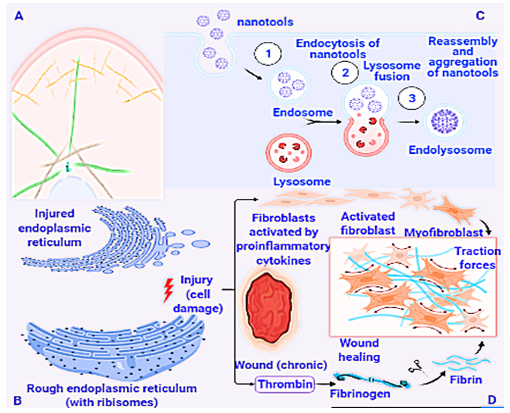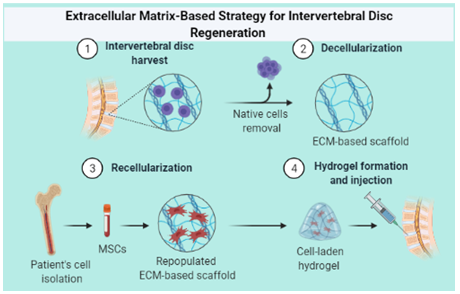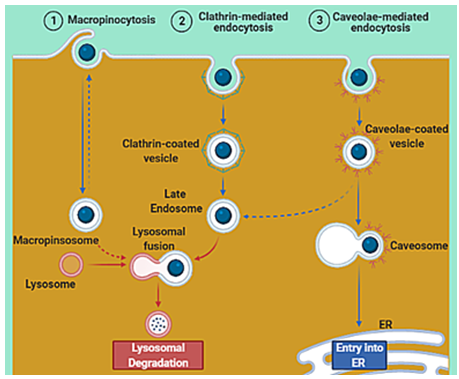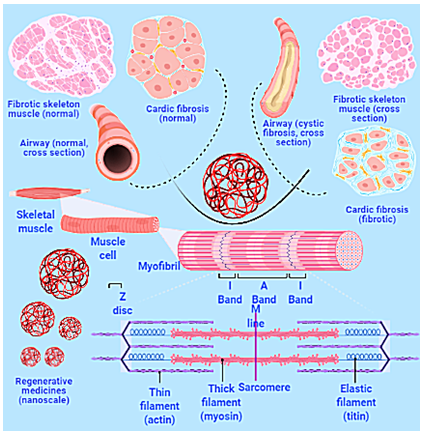Aditum Journal of Clinical and Biomedical Research
OPEN ACCESS | Volume 8 - Issue 1 - 2026
ISSN No: 2993-9968 | Journal DOI: 10.61148/2993-9968/AJCBR
Rajiv Kumar*1 and Mitrabasu Chhillar2
1NIET, National Institute of Medical Science, India.
2Naval Dockyard, Mumbai, India.
*Corresponding Author: Rajiv Kumar, NIET, National Institute of Medical Science, India.
Received: April 15, 2021
Accepted: April 20, 2021
Published: April 26, 2021
Citation: R Kumar and M Chhillar. (2021) “Nano-bio interface, bioadaptability of different nanoparticles, nanokicking and extracellular matrix mimicking: a biological and medicinal front to promote the concept of a cell, having a better defense system inbuilt by nature”, Aditum Journal of Clinical and Biomedical Research, 3(1); DOI: http;//doi.org/04.2021/1.1024.
Copyright: © 2021 Rajiv Kumar. This is an open access article distributed under the Creative Commons Attribution License, which permits unrestricted use, distribution, and reproduction in any medium, provided the original work is properly cited.
To have a better outlook on the effectiveness of nano-bio interface, and the bioadaptability of nanoparticles in regenerative remedies, the concept of the interface was counted in, and it was conferred that the features of different nanoparticles, as well as their impact on biology and medicine, and their commercialization prospects have directly concerned with regeneration and defense system of the cell. The role of nanomaterials in revolutionizing nanobiomedicine and in the development of nano-bio tools is important and helpful for understanding the nanomaterial-biological microenvironment and clinical translation of it into nanobiomedicine. A better acquaintance of nano-bio contact will expose new strategies and assistance in the designing of safe and effective nanomaterials for various biomedical applications. For a real interpretation and perfect elucidation, an experimental and theoretical line of attack is applied to explore nano-bio interfaces. The obtained outputs will deal with the persevere challenges in its development, as well as bring new hopes and opportunities for the implementation of nano-sized particles possessing crucial medicinal properties, and playing an important role in research, and development in searching for new applications in the field of chemistry, materials science, health sciences, biology, physics, and engineering. The bio-nano interface existed among nanomaterials, cell membrane, and intercellular matrix and has the ability to enhance the biological functioning of cells or activities of organs in a natural way for enhancing regeneration. The bio-nano interface and the transformations that undergo in the cellular environment along with multifunctional nanobiomaterials can affect the adsorption of biomolecules on the surface. Nano-bio interface and mimicking of the extracellular matrix are those featured phenomena that can generate nanovibrational stimulation and nanokicking for enhancing the adaptability of various nanoparticles, considered as better regenerative medicinal remedies for an effective nanotherapeutic impact for wound healing. Nano-bio interface is a concept, which has proper details of practices of nanomedicine at the nanoscale, can be applied for monitoring, controlling, repairing, regeneration, building a better immune defense, and improve the microenvironment of biological systems via applying various engineered nanodevices, tools, and nanomaterials.

Schematic representation of the wound healing. A. Extracellular matrix (ECM) mimicking, B. ECM as a biological and medicinal front to promote the concept of a cell, C. endocytosis and, bioadaptability of different nanoparticles, and D. nano-bio interface for enhancing wound healing, fibrosis, and the having a better defense system inbuilt by nature. Scaffold structural microenvironmental may be useful for tissue regeneration for bones. As scaffold pore structure (i.e., porosity and pore size), grain size, and surface topography, and how the mechanism scaffold microenvironmental cues guide bone tissue regeneration.
Introduction:
The cutting-edge nanotechnology displayed better lead-ins for transfiguring new therapeutics, and overall, it enhances the efficacy of medical therapy comparatively existing one. Nanotechnology is offering a novel therapeutic option that is not restricted up to state-of-the-art materials, and also inbuilt technology has the potential to design intelligent, and smart nanoscale tools and devices consisting of multifunctional nanomaterials, and biomaterials, distinctly applied and utilized in the preparation of nanotheranostics and nanotherapeutics.[1] The nanotools are capable of commensurate bioactive molecules to target the affected site, perform as control drug discharge machinery, and truly enrich the therapeutic efficacy and efficiency of drugs. That is why these remedies are notified as one of the best therapeutic options in the field of renewing and wound healing therapies.[2] The nanodrugs delivery tools and devices such as inorganic nanoparticles, liposomes, nanofibrous structures, polymeric nanoparticles, lipid nanoparticles, and nanohydrogel, are holding pivotal features and to be used as recreating and wound healing therapeutics. Recently, the wound healing potential of gold and its alloy was testified in-vitro antimicrobial and in-vivo.[3] Simultaneously, thermoresponsive gels containing gold nanoparticles as smart antibacterial and wound healing agents were also developed.[4] Furthermore, various other metal nanoparticles including zinc oxide, cerium oxide, terbium hydroxide, silica, and copper have been developed that exhibit therapeutic potential as a wound-healing element in vitro and in vivo models. Nanoparticles of platinum, selenium, tantalum oxide, iron oxide, and titanium dioxide nanoparticles were also synthesized and the possibilities of utilizing these kinds of nanoparticles as a noble source of regenerative medicine have also been examined and identified.[5] Nanoparticles of aurum, palladium, and platinum were also acclaimed wound healing potential and this class of nanoparticles also displayed a high grade of antioxidant individualities. Furthermore, the silver nanoparticles induced by nitric oxide and Chitosan are extolled, because they have wound healing properties. The graphene, oxides, and superparamagnetic ferric and nonmetallic inorganic were also investigated as novel remedies for regeneration and wound repair, and healing.[6] Moreover, nanoparticles of ceramic, bioactive glass nanoceramics and bioresorbable magnetic display wound healing potential. The bioactive inorganic/organic nanocomposites were also discovered as regenerative remedies for wound healing. Among the drugs included in the nanoformulations, the nanotherapeutics were developed by inducing them with antibiotics, natural extracts, proteins, and growth factors, among others.
Wound healing is a complex physiological phenomenon with sequential activation of multiple cell signaling pathways, routes, and cell types in a coordinated manner and therefore, it requires more sophisticated tools and devices for enhancing healing and repair. Along this side, different types of advanced antibacterial materials are required to prevent bacterial infection at the site of wound healing, because any infections will initiate delay and cause further severe complications in the recovery. To eradicate the persistent complexity of healing in a faster way and with a better outcome, a lot of serious efforts are in demand.[12] These complications could be highlighted and marked as of an improvement in a very well-mannered and considered during innovation. The implementation of such strategies can help in the advancement of antibacterial materials and simultaneously, will promote these themes to achieve novel and enriched antibacterial remedies with reusability, and good biocompatibility. These advanced tiny machines, tools, and devices can stimulate cell behaviors to promote healing in bacterially infected wounds.[13] Nanohydrogel having good antimicrobial effectiveness was also reported and marked as a better remedy in wound healing. Reported nano hydrogel does not initiate any abnormalities or damage to any major organs (heart, liver, spleen, lung, and kidney) in rats during clinical trials conducted for the wound healing process (Fig. 1). To fulfill the dreams to have an advanced form of nanomedicines that can do wonders as preventive and regenerative medicines, and could be emerged as the best nanotherapeutic options for healing wounds and injuries.[14] Therefore, most recently, many efforts have been done to achieve the aforementioned objectives. Nanotechnology is playing a crucial role to draw the blueprint of the therapeutic strategies according to the parameters and needs of the cell
mechanotransduction machinery. These efforts will be crucial for the development of successful drug delivery at the cellular level for boosting cellular immune defense, tissue regeneration, and grafting of scaffolds for cell growth. The innovation of such an efficient therapeutic and the up-gradation of nanodevices will be used for cell tracking and stimulating intracellular signaling pathways and play a crucial role in the regeneration and healing of wounds.[15] The authors are elaborating on different aspects of the discussed outlook of different multifunctional nanomaterials, that can be used in the formulation of preventive and regenerative medicine and will be recommended in the treatment of injuries and wounds. Few of the multifunctional nanomaterials have also been recommended to treat other fatal diseases (lupus erythematosus, creutzfeldt-Jakob disease, diabetes mellitus, asthma, common cold, cancer, Alzheimer's disease, Parkinson's disease, multiple sclerosis, lupus, schizophrenia, coronary artery disease, stroke, lower respiratory infections, chronic obstructive pulmonary disease, trachea, bronchus, and lung cancers, dehydration due to diarrheal diseases, and cirrhosis).[16] Thus, many other efforts have also been done for innovating therapeutic strategies specifically in the development of regenerative remedies and vascular tissue engineering.
Due to the smaller size, and high surface area, and volume ratio of the nanoparticles, they can enhance the probability of biological interaction and exhibit good permeation character desired at the wound site. Therefore, a more scientific effort will explore a wide range of properties of materials at the nanoscale that can boost wound healing in a faster way at different stages.

Figure 1: Biocompatibility, efficiency, and effectiveness of hydrogel and extracellular matrix mimicking: a biological and medicinal front in the disc regeneration.
These small tools and devices themselves having nanoscale topologies and that is why they can perform as a better carrier or advanced nanomaterials having an upper grade of therapeutic values. It is a very well-reported fact that these novel drug delivery tools displayed high stability, having tunable compositions, and carrying a large surface area, and highly capable of enhancing wound‐healing routes and states in vitro and in vivo prototypes.[17] These tiny tools can easily deal with the complexity of wound healing, but in yesteryears, it was a great challenge for clinicians to regenerate tissues and repair injury in a similar fashion.
These small nano-bio tools with inbuilt drug delivery vehicles display their medicinal properties and are considered as an ideal option for the delivery of drugs and importunately for enhancing cell signaling pathways and as well can perform other cellular events including cell proliferation, vascularization, eliciting cell-to-cell interactions, and elaboration of biomolecules needed for perfect wound healing.[18] The nanoparticles also have the ability to deliver one or more therapeutic drug molecules. These tiny tools are also capable of catalyzing and transporting growth factors, nucleic acids, antibiotics, and antioxidants and can release them in a sustained manner at the target tissue. The multifunctional nanomaterials have enormous potential to be considered as the best option in designing biomedical materials. The therapeutic devices/tools (nano scaffolds, nanoscale devices, and nanoscale surface-modified vascular scaffolds), referred to above, are highly capable of remodeling the cell mechanotransduction machinery and can stimulate and influence cell alignment, adhesion, and differentiation for enhancing endothelization at the nanoscale.[19] In biomedical imaging, the nanoscale contrast agents are utilized to track and monitor the diseased and injured area in the tissues and can be marked for regeneration.[20–22] Further, the nanotools and nanodevices displayed nanovibrational character (nanotopography and nanokicking) to stimulate and track the paths of the disease. These tools can easily distinguish between healthy and diseased cells. On-spot transportation of molecules of nanodrugs and biomolecules (macromolecules/proteins) is a major concern and discussed nano-bio tools can do it at the cellular level.[8] Therefore, only nanoscale preventive and regenerative therapy can be successful in healing the injured cells and wounds in the tissues because the nanodevices/nanocarriers are enabled with nanotherapeutic and highly capable to transport it. Besides it, they can influence cell behavior, and promote cell regeneration differentiated based on the phenotype, and genotype.[23] These nano-bio tools can easily re-model cell mechanotransduction machinery and stimulate the intracellular signaling pathways to achieve better therapeutic effectiveness. The details of such nanotools and devices are discussed here for better implementation in the healthcare sector.
Nano-bio interface and mimicking of extracellular matrix:
The nano/biomaterials utilized in the formation and the formulation of nano-bio tools and molecular designs. These molecular machines were employed in tissue engineering and developed new interfaces and emerged as the best scientific tool to promote and enhance cellular events such as proliferation and differentiation. The interface between biomedical/nanomaterials is the key for a successful invention and implementation thereafter as regenerative materials and wound healing therapy. Because of the aforementioned applications, nanomaterials are considered the best source for the formulation and synthesis of preventive and regenerative medicine [24]. The bio-nano interfaces catalyze the activities of tissue-engineered scaffolds at the nanoscale, mimic the extracellular matrix, and enhance cell adhesion [25]. The transportation of bioactive components occurred in the different cell compartments generally utilized for improving the immune systems to have a better defense against diseases and microbial infections. The nano-bio tools and devices also boost the natural immune system because all of them are carrying a high grade of therapeutic effectiveness and can transport the bioactive molecules for a better origin of the novel nano-bio interface. The positive medicinal outputs and their impact as a better remedy are evidenced by their potential and can be considered in the formation and formulation of preventive and regenerative remedies for better effectiveness.
Surface modification can also be done to achieve a better nano-bio interface. Immobilization of functional cell-adhesive ligands can be achieved by applying the above-mentioned techniques to modify the cellular incidents that can further stimulate the cellular activities and later on, will enhance healing routes of the wounds and injuries in a natural way.[26] In the continuation of the above-referred developments of current research, recently developed engineered nanofiber scaffolds have the potential to promote those cellular activities which are responsible for the initiation of the self-healing process by mimicking the native

Figure 2: Three major non-phagocytic cellular internalization pathways of nanoparticles (NPs): micropinocytosis, clathrin-mediated endocytosis, and caveolae-mediated endocytosis. The first two pathways generally lead to lysosomal degradation, while NPs entered via caveolae-mediated pathway can sometimes escape fusion with the lysosome. Therefore, designing NPs to enter through a caveolae-mediated pathway can increase the chances of successful drug delivery.
microenvironment, micropinocytosis, clathrin-mediated endocytosis, and caveolae-mediated endocytosis (Fig. 2). The concept of regenerative nanotherapeutics is an emerging multidisciplinary that is based on the theme “a cell has a better defense system inbuilt by nature”. Here, the same approach is implanted in the form of nanoscale devices, and materials that are induced to the cell microenvironment, are augmenting the functioning of cell organelles.[27] Therefore, these nano-bio tools have the potential to boost the natural defense mechanisms of a cell by a inhibit them and can stop the spreading of diseases and persisted infection. Therefore, their performance is acknowledged as a beat one and redefined the features of preventive and regenerative medicines. Furthermore, the regeneration of tissues can be succeeded by retelling the same routes on a large scale by implementing the nano-bio tools and scaffolds.[28] Emerged nano-bio interface having biological properties like living cells that can be defined as the biological front and in-built nanomaterials which are capable of promoting the regeneration and it can be underlined as a medicinal front.

Figure 3: Biocompatibility of these 3D scaffolds depends on the components (collagen, fibrin, elastin, chitosan, silk fibroin, chitin, gelatin, and fibrinogen) used for its manufacturing and the efficiency and effectiveness propositional interlinked and depends on physical parameters (stiffness, nanofibers, nanotubes, nanoparticles, structure, flexibility, pore size, and ligand density.
At the nanoscale, the nano-bio interface can perform remodeling of cell mechanotransduction machinery and stimulate intracellular signaling pathways. The formation of a nano-bio interface is defined as one of the components of a blueprint of regenerative medicines having the capabilities to open new doors after the discovery of discussed nanotherapeutic.[29] Such advanced proceedings lead the path of discovery in the area of regenerative therapeutic and it can be highlighted as one of the forefronts of nanoscale tools.[30] These innovations can be marked as a biological and medicinal front that can be applied to promote the concept “a cell, having a better defense system inbuilt by nature”. As mentioned earlier that the newly emerged nano-bio interface will mimic the extracellular matrix and perform as a biological and medical cover-up that can be termed as novel regenerative therapeutic, or outlined as the small tools for healing to care [31] as illustrated in (Fig. 3).
These therapeutics stimulate the extracellular matrix and mimic the nano-bio interface to initiate the cell signaling pathways that start the natural communication within or between the living cells. In other words, these nano-bio tools/interfaces may control cell behavior necessary for the regeneration progress.[32] During the cellular mechanisms, the nanoscale materials control various features necessary for the generation of simulation in biological components and counterparts as per the need of regeneration routes and states. Nano-bio tools are also capable of imagining, which can be helpful to understand the communication processes that occurred between the cells, and can be matter-of-source in the process of controlling cell behavior [33]. Surface modification of nanomaterials, designing of the scaffolds for better tissue engineering, fabrication of the nano/biomaterials, and the nanopatterning of the nano-bio surfaces are the current needs and areas to be researched to have an effective regenerative remedy.
There is a need for the up gradation of persistent complications that emerged in the path of designing nanoscale tools. Therefore, the intermediate steps are re-designed to disclose and expose the innovation methods applied in manufacturing small tools. Recently, it was evident that a spinal cord injury caused axonal junction defects that can seriously stop neuronal functioning. These injured neuronal cells and tissues are regenerated with the help of suggested regenerative therapy [34]. Suggested nanoscale tools and the regenerative bio/nanomaterials can also be performed as curative nanomedicine and may be useful for regenerating the damaged neuron cells.[35] During trials, the issues of material safety, performance, and effectiveness are considered and well addressed, because if these issues will be overruled, can be evidenced in inflammation, neurogenesis, angiogenesis, and apoptosis.
Nanovibrational stimulation and nanokicking:
Regeneration or regenerative medicines are the culmination of different fields and practices, as by adding growth factors, biomaterials, nanomaterials, and scaffolds, after that these therapeutics can repair, regenerate or replace damaged cells, tissues, and organs. Additionally, electrical stimulation, nutritional enhancers, nanoengineered cell-nanomaterial interfaces, nanovibrational stimulation, and nanokicking were innovated and generated by the nanoscale tools and devices in repairing, treating, or replacing diseased or damaged cells or tissues or organs gain normal cellular functioning.[36] Nanoscale featured nanotools are a key factor for the proper implementation of regenerative strategies, remodeling the cell mechanotransduction machinery and cellular functioning. Further, nanotechnology-based regenerative medicines are used for treating bone, muscle, cardiovascular, and neural tissue diseases. These strategies are very useful in various applications of molecular biology, genomics, and proteomics. The following facts summarize that the nanoparticles bio-mimetic matrices and scaffolds are capable of controlling, cellular adhesion, migration, and differentiation, cell fate, diagnostics, imaging, and targeted treatment, or according to the needs of the cellular environment and upgrade the understanding of cellular biology.[37] These sophisticated and scientifically approved small tools applied as regenerative medicines and displayed potential in mimicking physiological conditions and are doing wonders in the field of regenerative remedies and healing the cellular parts, remodeling the cellular activities, improving cell behaviors in vivo, and more outcomes yet to come (Fig. 4). Finally, the cell-surface and cell-biomaterials interactions dependent on surface receptors which are the main keys for the success of regenerative therapeutic.[38] Different aspects of the cellular microenvironment (ECM proteins, neighboring cells, the concentration of cell adhesion molecules, endocrine signaling, and ligands existing in neighboring cells and molecular signals) directly influence the cell behavior and controls the migration of cells within 3D microenvironments at a nanometre length scale.[39] Finally, the rationalized research findings also discourse the applications of nanoparticles embedded in secondary vehicles (fibers, dressings, hydrogels, etc.) for improving applicability and upgrade the therapeutic profile and its release route inactive form.

Figure 4: New myelin sheath formation and remodeling of it in the nervous system.
Nanoparticles comprise a hydroxyapatite core have also been prepared and can bind ions, proteins, and other organic molecules existed in the surrounding environment. Thus, the nano-bio can also influence the nano-bio interface, microenvironmental of the cells, and calcium levels.[40] Therefore, these tiny pieces of machinery displayed potential in modulating calcium homeostasis in-vivo. The pH-sensitive calcium-based nanoparticles were also developed and applied for the investigation and detection, and finally are able in enhancing the routes and paths of cutaneous wound repair and regeneration.
Conclusion:
Nano-bio interface is a good font for tissue engineering and regenerative medicine applications. These interfaces have multiple capabilities and effective for enhancing and controlling cell events and thus can be used in therapeutic healing and in vitro organ modeling. The bioadaptability of different nanoparticles, and extracellular matrix mimicking abilities transform these interfaces into special featured remedies that can improve the cellular environment and overall conditions. Various nano-bio tools have been designed to achieve an invented topological architecture, i.e. interface that can mimic extracellular matrix and improve intercellular communication for better regeneration. The authors are trying to highlight the importance of biomechanical cues during the action of the nano-bio interface and summarize the cell-ECM interactions and interface during infected states. Nanotechnology is a state-of-the-art technique used for designing various nano-bio tools and interfaces to remodel and control the biomechanical cues in vitro. In tissue engineering and regenerative medicine, the nano-bio interface provides biochemical signals to modulate cell behavior for better regeneration. As nature’s prototype for a biomaterial is the extracellular matrix, in a similar way, the nanotools and devices deal with the biological and medicinal front for originating nano-bio interface to copy the concept of a cell, having a better defense system inbuilt by nature, at the time of healing. Such methodologies and strategies are therefore highly relevant for modeling cellular events and can be achieved after using above mentioned novel therapies. These tiny tools are capable of doing alterations in the extracellular matrix composition and can alter mechanosensing and mechanotransduction as well as to deactivate activate signaling pathways that support disease expansion. The nanotools and their originated interface can influence cellular processes and events on the nano-, and micro-scale. Therefore, these findings are critical for tissue development and initiating the process of regeneration and healing, therefore, the authors are hoping that these biomechanics can be useful for healing and curing the infection in the future.
Acknowledgments:
One of the authors (Rajiv Kumar) gratefully acknowledges his younger brother Bitto for motivation. The authors acknowledge bio render for providing the facility to illustrate the diagrams (figures 1, 2, 3, and 4).
Availability of data and materials:
Wherever necessary, relevant citations are included in the reference section.
Competing interests:
The authors have declared that no competing interest exists
Author contributions:
RK supervised and wrote this review article. MB suggested some changes and modified them accordingly in the manuscript. Both authors approved the manuscript.